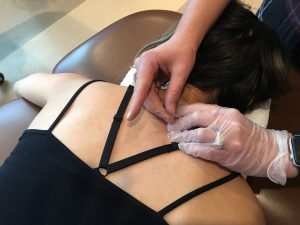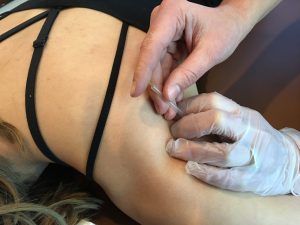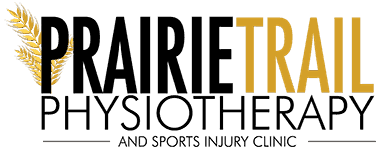Intramuscular dry needling is an acupuncture technique to aid in the treatment and management of chronic myofascial pain.
This technique involves the use of fine acupuncture needles (not comparable to those used to inject medicine or take blood samples) into specific trigger points within the muscle. The insertion of the needle into a normal muscle is painless. If a muscle is shortened the needling can cause a discomfort when the muscle grasps the needle. This is followed by a feeling of relaxation as the muscle releases. Transverse needling (across the muscle) makes the technique safe, reliable and effective.
The result of needling is three-fold including relaxation of the muscle, stimulation of the affected nerve and stimulation of the body’s natural healing process. All of these factors contribute to pain reduction.
Our physiotherapists have taken many of the advanced courses available:
Integrated Dry Needling (IDN) –https://integrateddryneedling.ca/
Gokavi Transverse Technique (GTT) .http://www.gokaviacupuncture.com/
GUNN Intramuscular Stimulation (IMS) https://www.gunnims.com/


At Prairie Trail Physiotherapy Clinic in Winnipeg, dry needling is used for the treatment of:
- Chronic muscular pain
- Chronic pain that has failed to respond to other treatments
- Idiopathic pain and pain exceeding normal healing times
- Pain from muscular trigger points
- Release of adhesions and scar tissue
- Increasing joint mobility
Each session lasts from 15 to 60 minutes. The number of treatments may vary depending on the problem begin treated. Every one of our physiotherapists is trained and certified with all of the latest dry needling techniques.
Dry Needling
Dry needling (DN) is a skilled intervention used by physical therapists that uses a thin filiform needle to penetrate the skin and stimulate underlying myofascial trigger points, muscular, and connective tissues for the management of neuromusculoskeletal pain and movement impairments. A trigger point describes a taut band of skeletal muscle located within a larger muscle group. Trigger points can be tender to the touch and can refer pain to distant parts of the body. Physical therapists utilize dry needling with the goal of releasing/inactivating the trigger points and relieving pain” – American Physical Therapy Association: Physical Therapists & The Performance of Dry Needling An Educational Resource Paper, 2012
Myofascial Trigger Points
A myofascial trigger point is a hyperirritable spot, usually within a taut band of skeletal muscle or in the muscle’s fascia.(1,2) These can be tender on palpation and can create referred muscle pain, which can feel like aching, boring, and sometimes sharp pain; some myofascial trigger points even creating muscle pain without being palpated or compressed.(1,2)
Myofascial trigger points are associated with muscle pain, loss of flexibility and range of motion, as well as functional weakness of a muscle.(2,3)
Prairie Trail Physiotherapists and Trigger Point Dry Needling
Our physiotherapists use the application of trigger point dry needling in their practice following a thorough assessment of your problem or injury. We create a management plan with you, focused on your physiotherapy goals; this can include other therapies such as manual therapy, manipulation, exercise and education.
We treat your dysfunction or injury as a whole and not simply treating the “victim” of your pain in isolation. Through our physiotherapy assessment, we help you get to the source of the dysfunction or pain.
Effects of Dry Needling
Dry needling has been demonstrated to have a significant effect on muscle tone and myofascial trigger points. This occurs through mechanical, electrophysical, chemical and neurophysiological mechanisms. Most of these effects are dependent on eliciting a local twist response at the trigger point.(4–7)
“Trigger point dry needling appears to reduce myofascial pain, regardless of body region, at various points in time.” – Boyles et al, Journal of Manual and Manipulative Therapy, 2015(8)
Dry Needling can be especially effective for muscle pain and myofascial pain syndromes when combined with other physiotherapy techniques and treatments, including hands on care, exercise and education.(9)
Dry Needling treatment has been shown in the research to have positive effects on numerous musculoskeletal pains. This includes:
- Temporomandibular Joint Pain and Dysfunction (TMD)(10–12)
- Mechanical Neck Pain(7,13)
- Headaches(14)
- Shoulder Pain(13,15)
- Low Back Pain(16)
- Plantar Fasciitis and Heel Pain(17,18)
- Fibromyalgia(19)
- Muscle pain created by myofascial trigger points(8)
Other areas that demonstrate significant improvement clinically include:
- Tendinopathies/Tendinitis
- Rotator Cuff
- Lateral or Medial epicondylosis (Tennis Elbow, Golfer’s Elbow)
- Achilles Tendinopathy
- Hip Pain or Arthritis
- Knee Pain or Arthritis
- Radiculopathies (nerve pain)
What to Expect:
Dry needling is a technique performed with acupuncture needles, but over the trigger points of your painful muscles. The needle used for this technique with very fine and there is no injection with dry needling. Dry needling does not require the needles to stay in once the local twitch response is triggered; therefore the treatment of each muscle is done very quickly. The areas that require treatment do require the skin to be exposed for dry needling treatment, so depending on the area to be treated, shorts, a tank top or one of our gowns may be necessary to wear to provide access.
After your treatment, it is common to have some local aching over the area of treatment, which usually dissipates between 4-8 hours after the treatment. Bruising can also occur, but this is less common.(20) Improvement in pain and mobility is typically noted immediately following treatment, however more chronic conditions can take up to 4-6 treatments to notice lasting changes. Some fatigue on the same day of treatment can also occur.
It is recommended to avoid strenuous activity or strength training on the same day following treatment until you know how your body and muscles respond to the dry needling treatment. Light activity, range of motion exercises and/or heat may be recommended for you following your treatment; this is discussed with your physiotherapists at the appointment.
How to Best Prepare for your Dry Needling Treatment:
- Have a snack or light meal prior to your treatment
- Be well rested if possible
- Be well hydrated
- Avoid getting dry needling if you are sick or have a fever
- Avoid alcohol and cigarettes prior to a needling session
Advise your physiotherapist of the following:
- All medical conditions
- Medications you are taking
- Past surgeries including any pacemakers, implants or joint replacements
- History of bacterial endocarditis or heart valve replacement
- Allergies to surgical steel or skin prep chemicals
- Pregnancy
Sarah Bleichert BMR-PT, MClSc-PT, SPC Sport Cert, FCAMPT
Physiotherapist, Prairie Trail Physiotherapy
Developer & Instructor for Integrated Dry Needling (IDN) Certification
